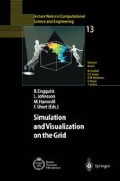Abstract
We describe new data structures for full and packed storage of dense symmetric/triangular arrays that generalize both. Using the new data structures, one is led to several new algorithms that save “half” the storage and outperform the current blocked-based level-3 algorithms in LAPACK. We concentrate on the simplest forms of the new algorithms and show for Cholesky factorization they are a direct generalization of LINPACK. This means that level-3 BLAS’s are not required to obtain level-3 performance. The replacement for level-3 BLAS are so-called kernel routines, and on IBM platforms they are producible from simple textbook type codes, by the XLF Fortran compiler. In the sequel I will label these “vanilla” codes. The results for Cholesky, on Power3 with a peak performance of 800 Mflop/s at n ≥ 200 is over 720 MFlop/s and reaches 735 MFlop/s. Using conventional full-format LAPACK DPOTRF with ESSL BLAS’s, one first gets 600 MFlop/s at n ≥ 600 and only reaches a peak of 620 MFlop/s. We have also produced simple square blocked full-matrix data formats where the blocks themselves are stored in column-major (Fortran) order or row-major (C) format. The simple algorithms of LU factorization with partial pivoting for this new data format is a direct generalization of LINPACK algorithm DGEFA. Again, no conventional level-3 BLAS’s are required; the replacements are again so-called kernel routines. Programming for squared blocked full-matrix format can be accomplished in standard Fortran through the use of three-and four-dimensional arrays. Thus, no new compiler support is necessary. Finally we mention that other more complicated algorithms are possible, for example, recursive ones. The recursive algorithms are also easily programmed via the use of tables that address where the blocks are stored in the two-dimensional recursive block array.
Access this chapter
Tax calculation will be finalised at checkout
Purchases are for personal use only
Preview
Unable to display preview. Download preview PDF.
References
R. C. Agarwal, F. G. Gustayson, and M. Zubair. Recursion leads to automatic variable blocking for dense linear-algebra algorithms. IBM Journal of Research and Development, 38(5):563–576, September 1994.
J. J. Dongarra, F. G. Gustayson, and A. Karp. Implementing linear algebra algorithms for dense matrices on a vector pipeline machine. SIAM Review, 26(1):91–112, January 1984.
. E. W. Elmroth and F. G. Gustayson. Applying recursion to serial and parallel QR factorization leads to better performance. Submitted to IBM Journal of Research and Development.
G. Golub and C. Van Loan. Matrix Computations. Johns Hopkins Press, Baltimore and London, second edition, 1989.
F. G. Gustayson. Notes on blocked packed format and square blocked format for symmetric/triangular arrays.
F. G. Gustayson. Recursion leads to automatic variable blocking for dense linear-algebra algorithms. IBM Journal of Research and Development, 41(6):737–755, November 1997.
F. G. Gustayson, A. Henriksson, I. Jonsson, B. Kågström, and P. Ling. Recursive blocked data formats and BLAS’s dense linear algebra algorithms. In B. Kågström et al., editors, Applied Parallel Computing: Large Scale Scientific and Industrial Problems, volume 1541 of Lecture Notes in Computer Science, pages 195–206, 1998.
F. G. Gustayson, A. Karaivanov, J. Wasniewski, and P. Yalamov. The efficiency of a new packed storage for symmetric indefinite matrices. Working draft, September 1999.
Author information
Authors and Affiliations
Editor information
Editors and Affiliations
Rights and permissions
Copyright information
© 2000 Springer-Verlag Berlin Heidelberg
About this paper
Cite this paper
Gustavson, F.G. (2000). New Generalized Data Structures for Matrices Lead to a Variety of High-Performance Algorithms. In: Engquist, B., Johnsson, L., Hammill, M., Short, F. (eds) Simulation and Visualization on the Grid. Lecture Notes in Computational Science and Engineering, vol 13. Springer, Berlin, Heidelberg. https://doi.org/10.1007/978-3-642-57313-2_4
Download citation
DOI: https://doi.org/10.1007/978-3-642-57313-2_4
Publisher Name: Springer, Berlin, Heidelberg
Print ISBN: 978-3-540-67264-7
Online ISBN: 978-3-642-57313-2
eBook Packages: Springer Book Archive

